Books
- “マンガでわかる!プログラミング 学校編: 怪盗Pのナゾをとけ!”,July 19, 2023. 理論社.
- “マンガでわかる!プログラミング 家の中編: たまった家事をかたづけろ!”,July 19, 2023. 理論社.
- “マンガでわかる!プログラミング 町の中編: 目的地へとたどりつけ!”,July 19, 2023. 理論社.
- “13歳からのPython入門: 新時代のヒーロー養成塾”,July 14, 2021. 東京化学同人.
- “つくって楽しいJavaScript入門 身近な不思議をプログラミングしてみよう”,2021. 翔泳社.
Journal Papers
- “クラス責務割当てのファジィ制約充足問題としての定式化”,情報処理学会論文誌, Vol. 58, No. 4, pp. 765-806, 2017年4月.
Abstract
本論文ではクラスへの責務割当てをファジィ制約充足問題として定式化することにより自動化を図る手法を提案する.責務とは各クラスのインスタンスが果たすべき役割を指し,それらをクラスへ適切に割り当てることによって,高品質な設計が実現される.割当に際しては,疎結合かつ高凝集な割当てが望ましいなど,様々な観点を考慮することが必要となる.しかし,そのような観点の間にはトレード・オフがあるため,現実的には条件を適度に満たす割当てが求められ,計算機による支援が重要である.そこで,様々な条件をファジィ制約として表現し,責務割当てをファジィ制約充足問題として定式化する.これによって,既存の汎用的なアルゴリズムを適用できるようになり,解としての責務割当ての導出が可能となる.例題に対して解を導出した結果を示す.
- “Color Scheme Adjustment by Fuzzy Constraint Satisfaction for Color Vision Deficiencies”,Color Research and Application, August, 2014.
Abstract
Color schemes or color combinations are widely used in printed materials and their digital versions, including web pages. These schemes convey information and create aesthetic appeal. Consequently, graphic designers have to strike a balance between accessibility and aesthetics with the color schemes they select. However, certain color schemes make the represented information confusing when viewers have color vision deficiencies (CVDs), which may lead to decrease in discriminability between used colors. What we will call the color-scheme-recoloring problem is the difficulty of optimizing a color scheme so as to preserve its original design and yet be simultaneously discriminable for all viewers, with or without CVDs. To address the problem, we formulated it within a framework of a fuzzy constraint satisfaction problem, a technique of artificial intelligence, and developed a tool for graphic designers. By utilizing the practical color co-ordinate system (PCCS), we introduce concepts used in the field of graphic design. This work combines pre-publication recoloring techniques for CVD viewers with elements of artificial intelligence, psychophysics, and psychology.
- “An Assessment Tool for Effective Monitoring of Autonomic Nervous System Activity in Healthy People”,Journal of Advanced Computational Intelligence and Intelligent Informatics, Vol. 18, No. 3, pp. 297-304, March, 2014.
Abstract
This paper proposes an application that analyzes and displays electrocardiograms (ECG; electrical activity of the heart over time) and plethysmograms (PTG; pulse waves produced by the heart pumping blood to the periphery) measured simultaneously. Recently in developed countries, chronic conditions typified by lifestyle-related diseases have become the leading cause of death. Simplified monitoring of the condition can be an effective approach to disease prevention and health promotion. We have focused on autonomic nervous system activity (ANSA) because it responds to stress as well as to changes in dietary patterns, and is correlated with hypertension, the source of some diseases, such as coronary disease. In this paper, we deal with both ECGs and PTGs as part of the biological data that reflects ANSA. The proposed application enables doctors to seamlessly negotiate analyzed waveforms and index charts of ECGs and PTGs in sync with each other. It also helps them comprehend the transition of ANSA. It offers a user interface (UI) that enables doctors to observe the two measures and the relationship between them for a quick assessment of ANSA; the sonification function of the ECG indices is implemented for providing the multi-modality of the UI. An experiment was conducted to confirm the feasibility of the analysis method of the application.
- “Reduction of the Beam Hardening Artifacts in the X-Ray Computer Tomography: Energy Discrimination with a Photon-Counting Detector”,World Journal of Nuclear Science and Technology, Vol. 2, No. 4, pp. 169-173, October, 2012.
Abstract
The material identification is a pressing requirement for the sensitive security applications. Dual-energy X-ray computer tomography (DXCT) has been investigated for material identification in the medical and security fields. It requires two tomographic images at sufficiently different energies. To discriminate dangerous materials of light elements such as plastic bombs in luggage, it is needed to measure accurately with several tens of kilo electron volts where such materials exhibit significant spectral differences. However, CT images in that energy region often include artifacts from beam hardening. To reduce these artifacts, a novel reconstruction method has been investigated. It is an extension of the Algebraic Reconstruction Technique and Total Variation (ART-TV) method that reduces the artifacts in a lower-energy CT image by referencing it to an image obtained at higher energy. The CT image of a titanium sample was reconstructed using this method in order to demonstrate the artifact reduction capability.
- “ユーザ・インタフェースを考慮した自律神経活動の簡易評価ソフトウェアの開発”,日本未病システム学会雑誌, Vol. 18, No. 1, pp. 85-89, 2012年 (発表研究論文).
Abstract
近年,先進国では,生活習慣病に代表される慢性疾患が主要な死亡原因となっており,日常生活における健康状況の簡易モニタリングが可能となれば,疾病予防と健康促進の有効な手段と成り得る.心疾患等の生活習慣病はストレスや食生活の変化を反映し,自律神経活動にも関連することが報告されている.一方,脈波伝播速度などの自律神経活動の評価指標は心電図と容積脈波から取得可能である.本研究では,同時計測した心電図と容積脈波の自動解析を行い,評価指標と波形の可視化を行う,自律神経活動の簡易評価ソフトウェアを開発したので報告する.
- “三種の色覚特性を考慮したファジィ制約充足による配色調整”,人工知能学会論文誌, Vol. 26, No. 5, pp. 518-526, 2011年.
Abstract
We propose a formulation of the problem of color scheme adjustment and a prototype system that automatically solves it, taking into account color vision deficiencies. Our work focuses on the representation of information, such as floor maps of public spaces and figures in books and papers. Color schemes of these representations carry two aspects: the aspect of art design and the aspect of media. The aspect of art design allows the creation of appealing color schemes using the sensitivity to beauty or theme of the contents. The aspect of media, on the other hand, provides information easy to understand. In particular, in the second aspect, designers need to consider universal design. However, these two aspects make any color scheme adjustments difficult, and the optimal combination of colors is not easily determined. The original color scheme made by a designer should not change drastically from the viewpoint of art, and at same time, the scheme must be understandable to everyone even to those with color vision deficiencies. To solve this difficulty posed to designers, we formulate our color scheme adjustment as a fuzzy constraint satisfaction problem, a framework studied in the field of artificial intelligence. In our formulation, we employ the index of color conspicuity, which defines how easily-noticeable a color is for retaining the impression of the original color scheme. To prove the feasibility of the concept, we develop a prototype system in Java that automatically adjusts colors given by a designer.
- “A Tool for Visualizing the Behavior of Fuzzy Constraint Satisfaction Solvers”,Journal of Advanced Computational Intelligence and Intelligent Informatics, Vol. 14, No. 5, pp. 425-430, February, 2010.
Abstract
This paper presents a software tool to intuitively comprehend and analyze fuzzy constraint satisfaction problems (FCSPs) through effective visualization with animation. FCSPs are an extension of constraint satisfaction problems (CSPs), which are used for formulating problems in real-world information systems. Once we formulate a problem as an FCSP, it can be solved (in principle) by any existing general-purpose FCSP solvers developed so far. However, the formulation is sometimes difficult because it requires high abstraction of real-world problems and affects the performance of the solvers. The authors believe that the tool will improve this situation by increasing the visibility of the behavior of the solvers.
- “動的ファジィ制約充足における解の安定性維持”,知能と情報(日本知能情報ファジィ学会誌), Vol. 21, No. 3, pp. 372-380, 2009年6月.
Abstract
ファジィ制約充足問題は人工知能の基礎戦術として知られる制約充足問題(CSP: Constraint Satisfaction Problem)を充足度を持たせることにより拡張した数理モデルである.一方,動的CSPの枠組みは現実世界における問題の部分的な変化と再求解を想定したモデルであり,その特徴は,問題を解きなおすコストの削減と解の安定性が求められることである.これら2つを組み合わせた数理モデルである動的ファジィCSP(DFCSP: Dynamic Fuzzy CSP)に関する研究は既存するが,CSPはNP完全問題として知られ,最悪計算量は指数オーダーとなることから,完全で高速な解法は存在しない.
本論文では,ファジィCSPのハイブリッド解法であるSRSアルゴリズムをDFCSPに適用し,さらに後処理としてのフィルタリングとしてSRSDアルゴリズムを導入することにより,大規模で複雑な問題に対しても,安定した実用的な許容解が得られることを,他の代表的な手法と比較することにより定量的に示す.
- “ファジィ制約充足に基づくウィジェットの適応レイアウト”,知能と情報(日本知能情報ファジィ学会誌), Vol. 20, No. 6, pp. 840-849, 2008年12月.
Abstract
本稿では,ウィジェットの適応レイアウト(FWL)問題に対する新しいアプローチを提案する.これは,FWLをファジィ制約充足問題(FCSP)として定式化するものである.グラフィカル・ユーザ・インタフェース(GUI)の自動生成において,ウィジェットのレイアウトの最適化は最も重要な課題の一つである.さらに,モデルに基づいたユーザ・インタフェース(UI)設計の分野では,UIの論理仕様記述の要求を満たすウィジェットの中から最適なものを選択することも必要である.このウィジェット選択を伴うレイアウトをFWLと呼ぶ.FWLでは,(1)どのウィジェットを使用し,それらをどのように並べるのかを決定すること,及び,特に実行時にUI生成を行う場合,(2)そのレイアウトをある時間内に完了させることの2点が要求される.本研究では,選択の望ましさをファジィ制約として定式化することによって,FCSPに対する既存の汎用的な手法をFWLに適用することを可能とした.そして,これによりウィジェットの選択とダイアログ・ボックス内への配置の自動化を実現した.特に,レイアウトの過程を三つのフェーズに分け,FCSPの解を求めるアルゴリズムを適用することにより,実用的な処理速度を実現した.
International Conference Presentations
Oral Presentations and Papers
Peer-Reviewed
- “Adaptive GUI Layout by Satisfying Fuzzy Constraints”,in Companion Proceedings of the 2023 ACM SIGCHI Symposium on Engineering Interactive Computing Systems, pp. 70-72, New York, NY, USA, June 26–30, 2023. Association for Computing Machinery.
Abstract
A graphical user interface is equipped with an adaptive layout when it holds the ability to dynamically adjust its layout and structure of widgets based on conditions that evolve over time coming from the end user, the platform used, and the environment. More specifically, such a layout automatically adapts itself depending on the window dimensions of the application, the screen resolution, and the screen size, thus posing a series of constraints that, sometimes, could not be entirely satisfied together at once. To cope with this variation, we formulate the adaptive GUI layout as a fuzzy constraint satisfaction problem in which the solver attempts to satisfy the most important constraints first, such as an appropriate widget selection, then the least important constraints after.
- “Class Responsibility Assignment as Fuzzy Constraint Satisfaction”,in Proceedings of 2014 6th International Workshop on Empirical Software Engineering in Practice, pp. 19-24, Osaka, Japan, November 12–13, 2014.
Abstract
We formulate the class responsibility assignment (CRA) problem as the fuzzy constraint satisfaction problem (FCSP) for automating CRA of high quality. Responsibilities are contracts or obligations of objects that they should assume, by aligning them to classes appropriately, quality designs realize. Typical conditions of a desirable design are having a low coupling between highly cohesive classes. However, because of a trade-off among such conditions, solutions that satisfy the conditions moderately are desired, and computer assistance is needed. Additionally, if we have an initial assignment, the improved one by our technique should keep the original assignment as much as possible because it involves with the intention of human designers. We represent such conditions as fuzzy constraints, and formulate CRA as FCSP. That enables us to apply common FCSP solvers to the problem and to derive solution representing a CRA. The conducted preliminary evaluation indicates the effectiveness of our technique.
- “Personalizing Graphical User Interfaces on Flexible Widget Layout”,in Proceedings of the 1st ACM SIGCHI Symposium on Engineering Interactive Computing Systems (EICS 2009), pp. 255-264, Pittsburgh, PA, USA, July 14–17, 2009. ACM Press.
Abstract
The authors propose a method for personalizing the flexible widget layout (FWL) by adjusting the desirability of widgets with a pairwise comparison method, and show its implementation and that it actually works. Personalization of graphical user interfaces (GUIs) is important from a perspective of usability, and it is a challenge in the field of model-based user interface designs. The FWL is a model- and optimization-based layout framework of GUIs offering a possibility for personalization, but it has not actually realized it with any concrete method yet. In this paper, the authors implement a method for personalization as a dialog box and incorporate it into the existing system of the FWL; thus, users can personalize layouts generated by the FWL system at run-time.
- “A Proposal of Context-Aware Service Composition Method Based on Analytic Hierarchy Process”,in Proceedings of the 1st KES International Symposium on Intelligent Decision Technologies (KES IDT 2009), New Advances in Intelligent Decision Technologies, pp. 65-71, Himeji, Japan, April 23–24, 2009. Springer.
Abstract
We propose a new service composition method with the analytic hierarchy process and discuss its availability. The concept of context-aware services has been attracting attention as an approach to improving the usability of computer-mediated services. In ubiquitous computing environments, there are several means to provide services for users, and thus, to select an appropriate mean among them is a challenge. Our method for context-aware service composition determines service behaviors by context data. Through the implementation and examination of the method, we have found that the method can output reasonable results.
- Proceeding © Springer-Verlag, in New Advances in Intelligent Decision Technologies
- Slides
- “Flexible Widget Layout Formulated as Fuzzy Constraint Satisfaction Problem”,in Proceedings of the 1st KES International Symposium on Intelligent Decision Technologies (KES IDT 2009), New Advances in Intelligent Decision Technologies, pp. 73-83, Himeji, Japan, April 23–24, 2009. Springer.
Abstract
We show an improvement of our previous work, a formulation of the flexible widget layout (FWL) problem as a fuzzy constraint satisfaction problem (FCSP) and a method for solving it. The automation of widget layout is one of the most important challenges for the generation of graphical user interfaces (GUIs). In the field of model-based user interface design, widget layout is more complicated because a layout system needs to select widgets. FWL is the automatic GUI generation requiring (1) deciding which widgets are used and (2) completing the layout immediately. We formulate the desirability of selection as fuzzy constraints; thus, we can utilize existing techniques of FCSP without extending its framework. We divide the layout process into three phases, and realize the automatic layout in feasible time.
- Proceeding © Springer-Verlag, in New Advances in Intelligent Decision Technologies
- Slides
- Demo
- “Keeping the Stability of Solutions to Dynamic Fuzzy CSPs”,in Proceedings of the 2008 IEEE International Conference on Systems, Man and Cybernetics (SMC 2008), Singapore, October 12–15, 2008. IEEE.
Abstract
A fuzzy constraint satisfaction problem is an extension of the classical CSP, a powerful tool for modeling various problems based on constraints among variables, and a dynamic CSP is a framework for modeling the transformation of problems. These schemes are the technique to formulate real world problems as CSPs more easily. The CSP model that combines these is already has splendid researches. The Fuzzy Local Change algorithm is practicable enough in small-scale problems, but larger problems require the use of approximate methods. The algorithms for solving CSPs are classified into two categories: systematic searches (complete methods based on search trees), and local searches (approximate methods based on iterative improvement). Both have advantages and disadvantages.
In the work reported in this paper we tested a hybrid approximate method, called the Spread-Repair-Shrink algorithm, on dynamic, large-scale problems. The algorithm repairs local constraints by repeatedly spreading and shrinking a set of search trees until the degree to which the worst constraints (the roots of the trees) are satisfied is improved. In this process, the "stability" of solutions can be maintained because the reassignment is locally limited. Additionally, we innovate SRSD filter as after filtering. We empirically show that Spread-Repair-Shrink and SRSD algorithm keep the stability of solutions rather than other algorithms. It is able to quickly get a good-quality approximate and stabile solution to a large problem.
- “Architecture for Migratory Adaptive User Interfaces”,in Proceedings of the IEEE 8th International Conference on Computer and Information Technology (CIT 2008), pp. 450-455, Sydney, Australia, July 8–11, 2008. IEEE.
Abstract
We propose a new solution named interface client/logic server (ICLS), targeting dialog-based interactive services, supporting user interface (UI) migration, and offering adaptive UIs for devices and services. Constant improvements of technology have brought a large variety of platforms, and that has made users' new demands about the services. The first is that the users would like to use services through different devices and modalities depending on their use contexts. The second is that the users would sometimes like to change devices and take their tasks from one to another, which is called UI migration. Our architecture ICLS is designed based on client/server model. In ICLS, we use XML documents written in abstract interaction description language (AIDL) as logical descriptions of UIs, and introduce one of the semantic web technologies adding the function of expressing meanings of interactions.
- “Interaction Description with Service-Specific Meanings”,in Proceedings of the 5th International Conference on Cybernetics and Information Technologies, Systems and Applications (CITSA 2008), pp. 185-188, Orlando, FL, USA, June 29–July 2, 2008. IIIS.
Abstract
An XML-based language, abstract interaction description language (AIDL), we propose, describes abstracted interactions instead of UI descriptions and includes meanings of these interactions. Computer-based services, which are various appliances and applications operated or utilized with user interface (UI) devices, have pervaded our everyday lives. Our approach, interface client/logic server (ICLS) is a model-based UI architecture supporting UI separation, generation, and migration comprehensively. It enables users to select various devices and services according to their different needs before or during service sessions. AIDL enables our architecture ICLS to handle interactions of specific service domains maintaining the independence of services from specific devices and modalities.
- “Keeping the Stability of Solutions in Dynamic Fuzzy CSPs”,in Proceedings of the 2008 IEEE Conference on Soft Computing in Industrial Applications (SMCia/08), pp. 382-386, Muroran, Japan, June 25–27, 2008. IEEE.
Abstract
A fuzzy constraint satisfaction problem (FCSP) is an extension of the classical CSP, a powerful tool for modeling various problems based on constraints among variables. Meanwhile, a dynamic CSP is a framework for modeling the dynamic transform of problems. These schemes are the technique to formulate real world problems as CSPs, more easily.
The CSP model that combines these is already has splendid researches. The Fuzzy Local Change algorithm is practicable enough in small-scale problems. However, when the scale of the problems grows to some degree, it becomes necessary to use approximate methods. Basically, the algorithms for solving CSPs are classified into two categories: the systematic search (complete methods based on search trees) and the local search (approximate methods based on iterative improvement). Both have merits and demerits.
In this paper, we tested a hybrid, approximate method called the SRS algorithm, in case of large-scale problems. SRS repeats spreading and shrinking a set of search trees in order to repair local constraints until the satisfaction degree of the worst constraints (which are the roots of the trees) is improved. In this process, the "stability" of solutions can be maintained because the reassignment is locally limited. We empirically show that SRS keeps the stability of solutions rather than starting the search from scratch. It is able to quickly get a good-quality approximate and stabilized solution of sufficiently large size of problems.
- “Flexible Widget Layout with Fuzzy Constraint Satisfaction”,in Proceedings of the 2008 IEEE Conference on Soft Computing in Industrial Applications (SMCia/08), pp. 387-392, Muroran, Japan, June 25–27, 2008. IEEE.
Abstract
We propose a new solution for the flexible widget layout (FWL) problem, formulating this problem as a fuzzy constraint satisfaction problem (FCSP) in the field of artificial intelligence. Widget layout performed by computers is one of the most important challenges for automatic generation of graphical user interfaces (GUIs). In the field of model-based user interface design, the widget layout is more complicated because the process of selecting widgets is needed. The FWL, we named, is the automatic GUI generation, which requires both (1) deciding which widget types and their alignments are used and (2) completing the layout in a certain time especially when the system generates them in run time. Our system automatically selects appropriate widgets and lays them out in certain rectangles. We formulate the desirability of the selection straightforward as fuzzy constraints; therefore, we can utilize existing technique of FCSP for the FWL. We divide the layout process into three phases, and using an existing FCSP algorithm, we realize the layout in a short time enough not to keep users of the generated GUI waiting.
- “User-Preferred Interface Design with Abstract Interaction Description Language”,in Proceedings of the 2006 IEEE International Conference on Systems, Man and Cybernetics (SMC 2006), pp. 2458-2463, Taipei, Taiwan, October 8–11, 2006. IEEE.
Abstract
For user-preferred interfaces, we propose a service architecture, the Interface-Client/Logic-Server (ICLS). It separates specific interfaces from services. An ICLS-based service consists of some interface clients and a logic server. The target of this work is the services with intermediary computers in various scenes of our daily activities. Nowadays, against various users' characteristics, the services offer different UIs individually, and they are mostly single GUI. In ICLS, users can switch interfaces of services to suit their preferences and to customize flexibly. Interface clients and logic servers work together independently with common descriptions of interaction. Those descriptions are written in the Abstract Interaction Description Language (AIDL), we propose. AIDL is an application of semantic web technologies, and describes interactions as graphs. These graphs represent a specification of interfaces and the current state of interactions constantly. We propose a framework of ICLS-based service design. Developers can use it like GUI toolkits. With this framework, we developed three clients and two servers.
Not-Reviewed
- “Automatic Color Scheme Adjustment for Different Color Vision”,in Proceedings of the 12th Takayanagi Kenjiro Memorial Symposium, pp. (S2-3-)1-4, Hamamatsu, Japan, November 18–19, 2010.
Abstract
The authors propose a system which adjusts automatically color schemes for different color vision. Designing color scheme is difficult problem because it has two aspects, art design and accessibility, and they relate to each other. We formulate color scheme problem as a fuzzy constraint satisfaction problem, and implement a prototype system for proving the feasibility of our method.
Poster Presentations
- “Development of Application for Brief Assessment of Autonomic Nervous Activity in Healthy People”,Proceedings of the 35th Annual International Conference of the IEEE Engineering in Medicine and Biology Society (EMBC ’13), p. [no data], Osaka, Japan, 2013年7月.
Abstract
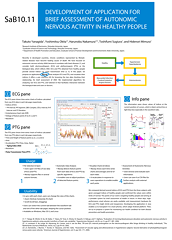 We propose an application that analyzes and visualizes electrocardiogram and plethysmogram data; it offers a user interface enabling users to browse the data checking their relation, for brief assessment of autonomic nervous activity (ANA). Our application enables users to traverse analyzed data seamlessly, and helps them comprehend the transition of ANA.
We propose an application that analyzes and visualizes electrocardiogram and plethysmogram data; it offers a user interface enabling users to browse the data checking their relation, for brief assessment of autonomic nervous activity (ANA). Our application enables users to traverse analyzed data seamlessly, and helps them comprehend the transition of ANA.
- “Mavep: An Application for Mibyo by Analyzing and Visualizing Electrocardiogram and Plethysmogram”,第4回国際健康長寿科学会議, p. 43, 静岡, 2011年10月21日.
Abstract
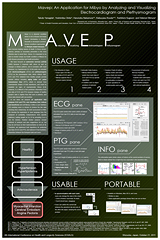 Recently in developed countries, chronic conditions represented by lifestyle-related diseases have become leading causes of death. In these circumstances, primary or secondary prevention is the most effective way to avoid them. Hence, it is important to be able to monitor simply our health condition for both disease prevention and health promotion.
Recently in developed countries, chronic conditions represented by lifestyle-related diseases have become leading causes of death. In these circumstances, primary or secondary prevention is the most effective way to avoid them. Hence, it is important to be able to monitor simply our health condition for both disease prevention and health promotion.
We have focused on autonomic nervous activity (ANA) because it responds with stress as well as changes in dietary patterns, and it correlates with heart diseases. In this work, we consider both electrocardiogram (ECG) and plethysmogram (PTG) as the physiological data that reflects ANA. ECG and PTG obtained from healthy people provide several indices including aging index and pulse transmission time, and could be available as signs of asymptomatic illness. However, it is difficult to find predictive information from raw data of ECG and PTG.
In our work, we propose an application that analyzes ECG and PTG, and visualizes their indices and waveforms and call Mavep; it offers a tailored user interface (UI) enabling users to browse the two data checking their relationship, for brief assessment of ANA. We develop the application in Java from the viewpoint of portability, independence from specific platforms, putting weight on its UI for providing it as a tool for doctors. We implement both algorithms for analyzing raw data of ECG and PTG, and tailored UI that facilitates interaction between the physiological data and users.
- “Improved Formulation of Flexible Widget Layout”,in Proceedings of the 2nd International Symposium on Global COE Program of Center for Next-Generation Information Technology based on Knowledge Discovery and Knowledge Federation (GCOE-NGIT 2009), Hokkaido University, Sapporo, Japan, January 20–21, 2009.
Abstract
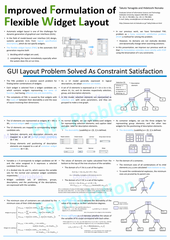 We propose an improvement of our previous work, a formulation of the flexible widget layout (FWL) problem as a fuzzy constraint satisfaction problem (FCSP). Automatic widget layout is an important challenge for the graphical user interfaces (GUIs) generation. In the field of model-based user interface design, the layout is more complicated because to select widgets is needed. FWL is GUI generations with deciding which widgets are used. In this paper, we improve our previous work so that the formulation coincides more strictly with FCSP.
We propose an improvement of our previous work, a formulation of the flexible widget layout (FWL) problem as a fuzzy constraint satisfaction problem (FCSP). Automatic widget layout is an important challenge for the graphical user interfaces (GUIs) generation. In the field of model-based user interface design, the layout is more complicated because to select widgets is needed. FWL is GUI generations with deciding which widgets are used. In this paper, we improve our previous work so that the formulation coincides more strictly with FCSP.
- “Migratory Adaptive User Interfaces”,in Proceedings of 2008 International Symposium on Global COE Program of Center for Next-Generation Information Technology based on Knowledge Discovery and Knowledge Federation (GCOE-NGIT 2008), Hokkaido University, Sapporo, Japan, January 22–23, 2008.
Abstract
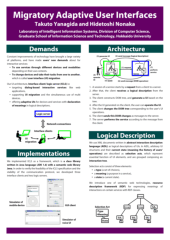 We propose a new solution named interface client/logic server (ICLS), targeting dialog-based interactive services, supporting user interface (UI) migration, and offering adaptive UIs for devices and services. Constant improvements of technology have brought a large variety of platforms, and that has made users' new demands about the services. The first is that the users would like to use services through different devices and modalities depending on their use contexts. The second is that the users would sometimes like to change devices and take their tasks from one to another, which is called UI migration. Our architecture ICLS is designed based on client/server model. In ICLS, we use XML documents written in abstract interaction description language (AIDL) as logical descriptions of UIs, and introduce one of the semantic web technologies adding the function of expressing meanings of interactions.
We propose a new solution named interface client/logic server (ICLS), targeting dialog-based interactive services, supporting user interface (UI) migration, and offering adaptive UIs for devices and services. Constant improvements of technology have brought a large variety of platforms, and that has made users' new demands about the services. The first is that the users would like to use services through different devices and modalities depending on their use contexts. The second is that the users would sometimes like to change devices and take their tasks from one to another, which is called UI migration. Our architecture ICLS is designed based on client/server model. In ICLS, we use XML documents written in abstract interaction description language (AIDL) as logical descriptions of UIs, and introduce one of the semantic web technologies adding the function of expressing meanings of interactions.
Domestic Conference Presentations
Oral Presentations and Papers
- “サイエンスとプログラミングを合わせた小中学生向け教育の実践”,第11回情報システム教育コンテストISECON2018, 情報処理学会情報システム教育委員会, 東京, 2019年3月23日.
- “サイエンス&プログラミング教室の試みと実践”,大学ICT推進協議会(AXIES)2018年度年次大会論文集, 札幌, 2018年11月20日.
Abstract
2014年秋から、株式会社スペースタイムではサイエンス教室とプログラミング教室とを合わせた小中学生向け教室を、「ラッコラ」と名付けて運営している。ラッコラの特徴は、同一のテーマをサイエンス編とプログラミング編とで相互補完的に扱う点、プログラミング編において、プログラミング言語として JavaScript を採用し、独自の開発環境を使用する点にある。本稿では、ラッコラの概略とこれまでの歩みについて説明する。
- “クラス責務割り当て問題へのファジィ制約充足問題の適用”,電子情報通信学会技術研究報告(SS,ソフトウェアサイエンス)SS2013-15, Vol. 113, No. 158, pp. 13-18, 札幌, 2013年7月25日 - 26日.
Abstract
本稿ではクラスへの責務割り当てをファジィ制約充足問題として定式化することにより自動化を図り,例題に対して解を導出した結果を示す.責務とは各クラスのインスタンスが果たすべき役割を指し,それらをクラスへ適切に割り当てることによって,高品質な設計が実現される.割り当てに際しては,疎結合かつ高凝集な割り当てが望ましいなど,様々な条件を考慮することが望ましい.しかしながら,そのような条件の間にはトレードオフがあるため,現実的には条件を適度に満たす割り当てが求められ,計算機による支援が必要となる.そこで,様々な条件をファジィ制約として表現し,責務割り当てをファジィ制約充足問題として定式化する.これによって,既存の汎用的なアルゴリズムを適用出来るようになり,解としての責務割り当ての導出が可能となる.
© 2013 IEICE
- “Visbye: ユーザ中心の仮想ディスプレイとその地図における応用例”,電子情報通信学会技術研究報告(HCS,ヒューマンコミュニケーション基礎)HCS2013-30, Vol. 113, No. 72, pp. 219-222, 那覇, 2013年5月30日 - 31日.
Abstract
携帯端末(スマートフォン,タブレットなど)を用いて,そのディスプレイ・サイズよりも大きなディスプレイをユーザの目の前に仮想的に表示するシステムを開発した.これは,デバイスの姿勢をデバイスに内蔵されたセンサーによって感知し,画面表示を更新することによって実現される.従来の画面タッチによるスクロールと比べ,身体動作を伴う事によりディスプレイに表示される内容の全体の把握が容易になることが期待される.本報告ではこのコンセプトの実装例として2種類のアプリケーションを示す.
© 2013 IEICE
- “PCCSに基づく自動配色調整ツール”,HCGシンポジウム2012, pp. [CD-ROM: HCG2012‐II‐7‐4], 熊本, 2012年12月10日 - 12日.
Abstract
配色(色の組み合わせ)は,様々な印刷物やウェブ・ページなどにおいて広く用いられており,アート・デザインとしての役割と媒体としての役割を持つ.したがって,これらの両方の役割を踏まえた配色を設計することはデザイナーにとっての課題となるが,ここで色覚特性への非依存性を考慮しようとした場合,色覚特性によっては特定の色の組み合わせの弁別が難しくなり,配色の意図する情報が伝わりにくくなることがあるため,設計はさらに困難となる.本稿では,この問題を扱うために著者らがこれまで提案してきた定式化手法を,PCCS(日本色研配色体系)を用いることによって拡張し,自動配色調整ツールとしての実装を示す.
© 2012 IEICE
- “データの楽曲としての可聴化―心電図データのドラム演奏化―”,人工知能学会, 第2回インタラクティブ情報アクセスと可視化マイニング研究会, pp. [PDF: SIG-AM-02-06], 横浜, 2012年11月16日.
Abstract
There are many methods for analyzing heavyweight and composited numeric data corresponding to various statistical matrix and types of data. Conventionally, for representation of these analytical results, charts and their extensions by three-dimensional view, animation, and interactivity are used. As one of the representations, we aim at sonification of analytical results, especially representation as music, for stimulating perceiving the difference of the target data. In this paper, we report software that generates drum play from arbitrary numeric data.
- “Heart Beat Drum: 未病診断のための心電図聴覚化”,電子情報通信学会技術研究報告(HIP,ヒューマン情報処理)HCS2012-8,HIP2012-8, Vol. 112, No. 45, pp. 43-46, 那覇, 2012年5月22日 - 23日.
Abstract
近年,先進国では,生活習慣病に代表される慢性疾患が主要な死亡原因となっており,日常生活における健康状況の簡易モニタリングは,疾病予防と健康促進の有効な手段と成り得る.本研究では,著者らが開発してきた心電図等の自動解析および視覚化ソフトウェアに,解析した指標値の聴覚化機能を新たに追加し,長時間に及ぶデータを解析する際のユーザ・インタフェースのマルチ・モーダル化を図った.
© 2012 IEICE
- “白色X線とエネルギー弁別型フォトンカウンティング検出器によるDual X-ray CT撮像に関する研究”,2011年映像情報メディア学会冬季大会講演予稿集, 東京, 2011年12月21日 - 22日.
Abstract
To improve the precision of the material identification by Dual X-ray CT with polychromatic X-ray and energy discriminative detector, it is needed to acquire the energetic distribution of CT value accurately. Using sinograms and CT values from different energy by energy discriminative detection, a method to remove beam hardening error was examined.
- “加速度脈波からの加齢指数自動検出の試み”,平成23年度日本生体医工学会東海支部学術集会, p. 36, 名古屋, 2011年10月15日.
Abstract
近年の先進国での主死亡原因は生活習慣病を中心とした慢性疾患であり,疾病予防と健康促進のために健康状況の簡易モニター・システムが必要とされている.著者らは,ストレスや食生活の変化を反映した自律神経活動(ANA)に着目し,健康な被験者の心電図と容積脈波(PTG)から,ANAの評価指標を自動算出し,簡易評価を行うためのアプリケーションの開発を目指している.本稿では提案手法を用いて,PTGから経時的に変化する加齢指数(AGI)を求める.
- “低ステップ高速X線CTにおける再構成像の形状改善と評価”,平成23年度電気関係学会東海支部連合大会, pp. [CD-ROM: H3-8], 津, 2011年9月26日 - 27日.
- “超低ステップX線CTのための非反復型再構成法”,2011年春季第58回応用物理学会学術講演会講演予稿集, pp. [DVD-ROM: 24p-EA-4], 厚木, 2011年3月24日 - 27日.
Abstract
非破壊検査技術であるX線CTは,医療や産業,セキュリティなどの様々な分野において利用されている.しかしながら,CT像(断面像)の取得には,通常,多ステップ(方向)からのX線照射が必要となるため,透過像撮像に比べて時間がかかり,全数検査等への応用は難しい.そこで著者らは,医療用の精度を必要としない分野を対象とし,高速な情報取得を可能とする超低ステップX線CTシステムの研究開発を行っている.
X線CT像は,複数の角度から照射されたX線が対象物を透過した際の減弱係数に基づいて再構成される.理想的にはあらゆる角度からX線を照射することが望ましいが,様々な制約(本稿では特に時間的制約)から困難であり,それ故,再構成されたCT像には,アーチファクトと呼ばれる像の乱れや歪みが発生してしまう.超低ステップX線CTシステムの実現には,再構成時におけるアーチファクトの低減が鍵となる.
- 要旨 © 社団法人応用物理学会
- “色のカテゴリカル知覚と三種の色覚特性を考慮した配色調整”,電子情報通信学会技術研究報告(ITS,画像工学)ITS2010-65,IE2010-140, Vol. 110, No. 420, pp. 275-280, 札幌, 2011年2月21日 - 22日.
Abstract
本稿では,色のカテゴリカル知覚と色覚特性の違いを考慮した,配色調整問題の定式化手法と,その実装を提案する.提案手法は,公共スペースのフロア・マップや書籍や論文などの図といった,情報の表現に焦点を当てている.これらの情報表現には,アート・デザインと媒体の二つの側面があるため,配色の調整には困難が伴い,最適な配色の組み合わせは容易には決定されない.著者らは,この問題に対する取り組みとして,人工知能の一分野であるファジィ制約充足問題として定式化する手法を既に提案している.本稿では,色のカテゴリカル知覚(色名と色覚の関係)に着目し,提案手法を改良する.また,この手法のグレースケール変換への応用例を示す.
© 2011 IEICE
- “コサイン類似度を用いたX線CT画像の評価”,2010年秋季第71回応用物理学会学術講演会講演予稿集, pp. [DVD-ROM: 15a-J-7], 長崎, 2010年9月14日 - 17日.
Abstract
現在X線CTは,医療用のみならず,産業やセキュリティなどの様々な分野で非破壊検査技術として活用されている.しかし,通常のCT撮像では多方向(多ステップ)からX線を照射する必要があり透過像撮像に比べて時間がかかるため,全数検査などに利用しにくい.そこで著者らは,医療用途ほどの精度の必要とされない分野を対象として,画像再構成時に適切な補正を加えることにより高速に情報を取得可能なX線CTシステム(低ステップX線CT)の研究開発を行っている.
- “北大総合博物館 宇宙の4Dシアター ~「Mitaka」を利用した大学博物館アウトリーチ活動の試み~”,日本地球惑星科学連合2010年大会予稿集, pp. [CD-ROM: GSC020-13], 千葉, 2010年5月23日.
- “ファジィ制約充足によるアート・デザインに向けたレイアウト手法”,ヒューマンインタフェース学会研究報告集, Vol. 12, No. 1, pp. 93-96, 浜松, 2010年3月4日 - 5日.
Abstract
Art design is made of a set of rules (constraints). In a design of posters, for example, many constraints are known: A title should be more appealing than other elements; and the alignment of and the distance between a text and a figure should be arranged based on their reference relation. The author intends to automate layout in art design, which consists of many constraints like above. In this paper, as a first step, the author proposes a system that solves positional relation among layout elements using the framework of fuzzy constraint satisfaction.
- “抽象インタラクション記述を用いたインタフェース・マイグレーション”,電子情報通信学会技術研究報告(ソフトウェアサイエンス)SS2007-24, Vol. 107, No. 176, pp. 49-52, 札幌, 2007年8月2日 - 3日.
Abstract
抽象的なインタラクションの記述を用いることによって,異なるモダリティを持つユーザ・インタフェース(UI)間のインタフェース・マイグレーションを実現する.ユーザがサービスを利用中にそれを中断することなく,また,それまでの入力結果を損なうことなくUIを変更することをインタフェース・マイグレーションという.本研究では,筆者らがこれまで開発してきた抽象インタラクション記述言語,ならびにそれを用いたUIフレームワークを拡張し,マイグレーション機構を実装する.
© 2007 IEICE
- “マッピング手法の導入によるインタラクション・モデルの拡張”,電子情報通信学会技術研究報告(ソフトウェアサイエンス)SS2006-37, Vol. 106, No. 202, pp. 19-22, 札幌, 2006年8月3日.
Abstract
既存のサービスのヒューマン・インタフェースには,設計者によってあらかじめ定義され固定されたものであるという不便な状況が見受けられる.筆者らはこれまで,インタラクションの記述を用いることによってこのインタフェースを任意に交換可能とするサービス・アーキテクチャ提案してきた.本稿ではこのアーキテクチャにおいて用いられるインタラクション・モデルを拡張し,選択肢のマッピングを記述する手法を導入する.これによって特定のデバイスやスタイルに依存することなく,インタラクションの記述をより表現力豊かなものにする.
© 2006 IEICE
- “ユーザ嗜好インタフェース実現のためのセマンティック・ウェブ応用”,平成17年度電気・情報関係学会北海道支部連合大会, pp. [CD-ROM], 札幌, 2005年10月22日 - 23日.
Abstract
コンピュータを接点としたサービスとして(ウェブ)アプリケーションや(情報)家電製品が挙げられる.このようなサービスの普及により,それらのヒューマン・インタフェースに接する機会が増加している.
現状では,ユーザはサービスの提供する固定的なインタフェースを使わざるを得ない状況にある.そのため,操作方法習得のコストや,ユーザの特性に適したインタフェースを使いたいという要求が高まりつつある.
筆者らはこれまで,サービスから切り離された,サービス独立のインタフェースを実現することによって,この状況の改善を図ってきた.本稿では,ユーザ嗜好インタフェースを実現するためのセマンティック・ウェブ技術の応用手法について述べる.
- “セマンティック・ウェブ技術を応用したユーザ嗜好インタフェースの実現”,電子情報通信学会技術研究報告(ソフトウェアサイエンス)SS2005-28, Vol. 105, No. 228, pp. 25-30, 小樽, 2005年8月4日 - 5日.
Abstract
本稿ではユーザ嗜好インタフェースの設計アーキテクチャを提案する.このアーキテクチャはサービスからインタフェースの特定のスタイルに依存する部分を切り離し,結果としてサービスのインタラクション仕様やユーザの嗜好に沿った,さまざまな構成のインタフェースが実現可能となる.これは我々が日頃経験する,情報社会におけるサービスが提供するインタフェースがGUIなど特定の形態に限定されているという不便な状況を改善するものである.また,アーキテクチャはインタフェースの細部と無関係にサービスを開発することを可能にする.このインタラクションの記述とインタフェースの構成アルゴリズムはセマンティック・ウェブ技術に基づいている.本文ではシステム・アーキテクチャと実装例について示している.
© 2005 IEICE
- “サービス・ロジックとインタフェースの分離によるユーザ嗜好モダリティの実現”,ヒューマンインタフェース学会研究報告集(第29回ヒューマンインタフェース学会研究会「ユビキタスインタフェース&アプリケーション及び一般」), Vol. 6, No. 4, pp. 43-48, 東京, 2004年11月5日.
Abstract
本論文は,サービス・ロジックとインタフェースの分離によるユーザ嗜好モダリティのためのシステム・アーキテクチャを提案する.近年,本の購入といったウェブ・サービスや,外出先から操作できるビデオ,炊飯器といった情報家電が用いられている.多くのこれらのインタフェースは,ユーザ特性,すなわちユーザの身体的特徴や好み,利用のコンテクストにかかわらず,GUIである.このモダリティの問題を扱ういくつかの解決策がある.その中のいくつかは,マルチモーダルなインタフェース開発のためのツールである.しかしながら,ユーザ特性を推測するのは困難である.我々のシステムの目的は,ユーザがサービスを自らが持つインタフェースによって,状況に応じて利用できる環境の提供である.インタフェースは従来のサービスから切り離され,オン・デマンドで接続される.インタフェースの記述はマルチモーダルなインタフェースを生成するために,高度に抽象化されていなくてはならない.そこで,我々は抽象インタラクション記述言語(AIDL)という言語を開発した.インタフェースの記述から実際に操作するインタフェースを生成するために,システムは知的情報技術を用いて,ユーザ特性とインタフェース生成システムの能力との整合性を解決する.
- “抽象インタラクション記述によるロジックとインタフェースの分離”,平成16年度電気・情報関係学会北海道支部連合大会, p. 257, 函館, 2004年10月23日 - 24日.
Abstract
交通機関のチケット予約,書籍の通信販売といったサービスが広く利用されるようになってきた.しかし,提供されるインタフェースがGUIのみであったり,同じGUIであっても操作方法がそれぞれ異なるという不便な状況がしばしば見受けられるようになってきた.
ユーザの希望するインタフェースを一番良く知っているのはユーザである.この考えと上で述べた現状を踏まえ,本研究の趣旨は最も自分に適したインタフェースを,サービスの提供者ではなく,ユーザ自身が用意できるようにすることである.
本研究ではインタフェースの記述を抽象化し,さまざまな形態のインタフェースをいかに統合して記述し生成するか,またサービスからインタフェースをどのように分離し,両者を連携させるかを中心に研究開発を進めている.
本稿では,このようなシステムの概要について述べる.
- “木構造モデルによるインタフェースとロジックの分離”,情報処理学会北海道支部シンポジウム2004, pp. 40-41, 札幌, 2004年5月24日 - 25日.
Abstract
今日,交通機関のチケット予約,書籍の通信販売といったサービスが広く利用されるようになり,また外出先から操作可能な情報家電製品などが登場してきた.しかし現状のアプリケーション(サービス)には,それぞれ別々の操作方法を習得する必要があったり,様々な使用環境に対しGUIしか提供されていないという問題がある.
ところがアプリケーションごとにインタフェースを実装する従来の方式では,すべての操作方法を統一したり,アプリケーションの提供者が複数のインタフェースを用意することは困難である.従来研究として,インタフェース記述言語UIMLや,GUIを文字情報に変換する研究があるが,問題解決には至っていない.
そこで本研究では,複数のアプリケーションでユーザが好みのインタフェースを統一して使え,また状況に応じて様々なインタフェースに取り替えられるようにすることを目的とした,新しいアプリケーション・システムを提案し,その実装例を示す.
Poster Presentations
- “ズーミング・インタフェースによる自律神経活動簡易評価ソフトウェア”,第20回日本未病システム学会学術総会抄録集, p. 151, 東京, 2013年11月9日 - 10日 (優秀演題賞受賞).
Abstract
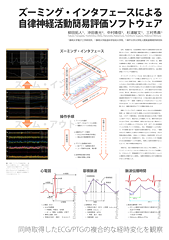 近年,先進国では,生活習慣病に代表される慢性疾患が主死亡原因となっており,疾病予防と健康促進を目的とした健康状況の簡易測定が必要とされている.著者らはこれまで,ストレスや食生活の変化を反映した心臓病等に関連する自律神経活動(ANA)に着目してきた.ANAの評価指標(脈波伝播時間(PTT)を含む)は,健康な被験者の心電図(ECG)と容積脈波(PTG)から得られる.本稿では,ECG とPTGの解析を行い,ズーミング・インタフェースによる,評価指標と波形の可視化と簡便な操作性を実現する,ANA 簡易評価ソフトウェアを提案する.
近年,先進国では,生活習慣病に代表される慢性疾患が主死亡原因となっており,疾病予防と健康促進を目的とした健康状況の簡易測定が必要とされている.著者らはこれまで,ストレスや食生活の変化を反映した心臓病等に関連する自律神経活動(ANA)に着目してきた.ANAの評価指標(脈波伝播時間(PTT)を含む)は,健康な被験者の心電図(ECG)と容積脈波(PTG)から得られる.本稿では,ECG とPTGの解析を行い,ズーミング・インタフェースによる,評価指標と波形の可視化と簡便な操作性を実現する,ANA 簡易評価ソフトウェアを提案する.
- “野菜摂取前後における短時間の加速度脈波及び脈波伝播速度の影響―被験者内と被験者間の変動について検討―”,第19回日本未病システム学会学術総会抄録集, p. 93, 金沢, 2012年10月27日 - 28日.
Abstract
- “高エネルギーCT画像の参照によるアーチファクト削減方法”,2012年秋季第73回応用物理学会学術講演会講演予稿集, pp. [DVD-ROM: 12p-PA2-19], 松山, 2012年9月11日 - 14日.
Abstract
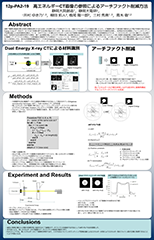 X線CT撮像は検査対象の内部の情報を得られるため多くの分野において応用されている.X線のエネルギーごとの減弱の違いにより,CT画像を用いて実効原子番号および電子密度を求めるDual Energy X-ray CT(DXCT)はこれまで医療分野での応用が進められてきた.我々はセキュリティや非破壊検査の分野におけるDXCTの適用を目指し,従来型の白色X線管とフォトンカウンティング型検出器による材料識別を検討している.DXCTでは二つの異なるエネルギーにおけるCT画像の線源弱係数の差を利用して材料識別を行うため,二つのエネルギーは十分に離れている必要がある.従来型の白色X線を利用する場合,数十keV程度の低いエネルギー帯域を用いる必要があるが,このような帯域では検出器におけるカウント数と物質の透過距離との間の線形性が失われ,CT画像にアーチファクトが発生して材料識別の精度を下げる原因の一つとなっている.本研究はこの非線形性によるアーチファクトを,より高いエネルギーのCT像を参照することにより低減することを目的とする.逐次近似画像再構成法の一つであるArgebraic Reconstruction Technique(ART)- Total Variation(TV)法へ,より高いエネルギー帯域でのCT像を参照し補正するステップを組み込む方法を提案した.この方法によりチタンシリンダーのCT像を再構成し,アーチファクトが低減することを確認した.
X線CT撮像は検査対象の内部の情報を得られるため多くの分野において応用されている.X線のエネルギーごとの減弱の違いにより,CT画像を用いて実効原子番号および電子密度を求めるDual Energy X-ray CT(DXCT)はこれまで医療分野での応用が進められてきた.我々はセキュリティや非破壊検査の分野におけるDXCTの適用を目指し,従来型の白色X線管とフォトンカウンティング型検出器による材料識別を検討している.DXCTでは二つの異なるエネルギーにおけるCT画像の線源弱係数の差を利用して材料識別を行うため,二つのエネルギーは十分に離れている必要がある.従来型の白色X線を利用する場合,数十keV程度の低いエネルギー帯域を用いる必要があるが,このような帯域では検出器におけるカウント数と物質の透過距離との間の線形性が失われ,CT画像にアーチファクトが発生して材料識別の精度を下げる原因の一つとなっている.本研究はこの非線形性によるアーチファクトを,より高いエネルギーのCT像を参照することにより低減することを目的とする.逐次近似画像再構成法の一つであるArgebraic Reconstruction Technique(ART)- Total Variation(TV)法へ,より高いエネルギー帯域でのCT像を参照し補正するステップを組み込む方法を提案した.この方法によりチタンシリンダーのCT像を再構成し,アーチファクトが低減することを確認した.
- ポスター © 社団法人応用物理学会
- “ユーザ・インタフェースを考慮した自律神経活動の簡易評価ソフトウェアの開発”,第18回日本未病システム学会学術総会抄録集, p. 128, 名古屋, 2011年11月19日 - 20日.
Abstract
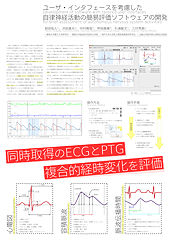 近年,先進国では,生活習慣病に代表される慢性疾患が主死亡原因となっており,疾病予防と健康促進を目的とした健康状況の簡易測定が必要とされている.著者らはこれまで,ストレスや食生活の変化を反映した心臓病等に関連する自律神経活動(ANA)に着目してきた.ANAの評価指標(脈波伝播時間(PTT)を含む)は,健康な被験者の心電図(ECG)と容積脈波(PTG)から得られる.本稿では,ECGとPTGの解析,評価指標と波形の可視化を行い,ユーザ・インタフェース(UI)を提供する,ANA簡易評価ソフトウェアを提案する.
近年,先進国では,生活習慣病に代表される慢性疾患が主死亡原因となっており,疾病予防と健康促進を目的とした健康状況の簡易測定が必要とされている.著者らはこれまで,ストレスや食生活の変化を反映した心臓病等に関連する自律神経活動(ANA)に着目してきた.ANAの評価指標(脈波伝播時間(PTT)を含む)は,健康な被験者の心電図(ECG)と容積脈波(PTG)から得られる.本稿では,ECGとPTGの解析,評価指標と波形の可視化を行い,ユーザ・インタフェース(UI)を提供する,ANA簡易評価ソフトウェアを提案する.
- “人工知能を応用した配色支援ツール”,第3回国際ユニヴァーサルデザイン会議「浜松ほっとコーナー」, 浜松, 2010年10月29日 - 11月3日.
Abstract
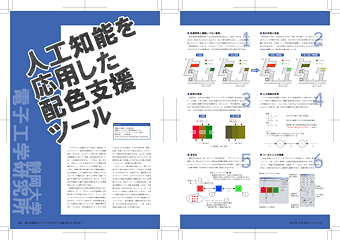 シンポジウム会場等における表示(案内板)やパンフレット,従来の印刷物をベースとした情報表示,ならびに,ウェブページ等における電子的な情報表示において,配色(色の組み合わせ)には二つの側面が存在する.一つ目は,美しさやテーマ性といったいわゆるデザイナーが感性を発揮するアート・デザインとしての側面であり,二つ目は,情報を受け取る側に対して情報を適切に伝える媒体としての側面である.後者は,アクセシビリティの観点から,個々人の特性(色覚)の違いを考慮することが望まれる.従って,これら両方の側面から優れた配色を導き出すことが情報表示において必要不可欠である.
シンポジウム会場等における表示(案内板)やパンフレット,従来の印刷物をベースとした情報表示,ならびに,ウェブページ等における電子的な情報表示において,配色(色の組み合わせ)には二つの側面が存在する.一つ目は,美しさやテーマ性といったいわゆるデザイナーが感性を発揮するアート・デザインとしての側面であり,二つ目は,情報を受け取る側に対して情報を適切に伝える媒体としての側面である.後者は,アクセシビリティの観点から,個々人の特性(色覚)の違いを考慮することが望まれる.従って,これら両方の側面から優れた配色を導き出すことが情報表示において必要不可欠である.
物理的な物体がそれ自体の固有の色を持つのとは異なり,アート・デザインにおける要素には任意の色づけが可能である.そして,アート・デザインとアクセシビリティには様々な要素が関連するために,デザインの途中で,ある程度出来上がった配色を改善しようとしても,困難な場合が多い.たとえば,2色の配色のコントラストを向上させようとする場合,どちらの色の何(明度,彩度,色相)をどれだけ変えるのか,パラメーターの組み合わせは膨大になる.しかも,元の配色の印象を出来るだけ変えないようにしたり,色覚特性の違いを考慮したりするなどの様々な制約(=バランス)を考慮する必要がある.
フロア・マップ表示等を対象として,誰にでも見やすい表示を誰もがデザインできるような支援ツールを作れないか.本研究では,情報表示においてアート・デザインとアクセシビリティを両立させるよう配色を自動的に調整するシステムを提案している.手法として,人工知能を応用し,配色の問題をファジィ制約充足問題(FCSP)の枠組みを用いて定式化する.そして,ユーザー(デザイナー)が指定した配色パターンを元に,上述した制約を満たすように配色を自動調整するツールのプロトタイプを開発している.現段階では,コントラスト,色の誘目性(複数の色の中における,それら色の目の引きやすさ),1型,2型2色覚を考慮させることが可能である.
- “情報表示における配色提案の自動化”,第5回博物科学会講演要旨集, p. 33, 仙台, 2010年6月24日.
Abstract
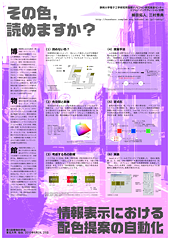 博物館等における表示(案内版)やパンフレット,従来の印刷物をベースとした情報表示,ならびに,ウェブページ等における電子的な情報表示において,配色(色の組み合わせ)の決定には二つの側面が存在する.一つ目は,美しさやテーマ性といったいわゆるデザイナーが感性を発揮するアート・デザインとしての側面であり,二つ目は,情報を受け取る側に対して情報を適切に伝える媒体としての側面である.後者は,アクセシビリティの観点から,個々人の特性の違いを考慮することが望まれる.従って,これら両方の側面から優れた配色を導き出すことが情報表示において必要不可欠である.
博物館等における表示(案内版)やパンフレット,従来の印刷物をベースとした情報表示,ならびに,ウェブページ等における電子的な情報表示において,配色(色の組み合わせ)の決定には二つの側面が存在する.一つ目は,美しさやテーマ性といったいわゆるデザイナーが感性を発揮するアート・デザインとしての側面であり,二つ目は,情報を受け取る側に対して情報を適切に伝える媒体としての側面である.後者は,アクセシビリティの観点から,個々人の特性の違いを考慮することが望まれる.従って,これら両方の側面から優れた配色を導き出すことが情報表示において必要不可欠である.
物理的な物体がそれ自体の固有の色を持つのとは異なり,アート・デザインにおける要素には任意の色づけが可能である.そして,アート・デザインとアクセシビリティには様々な要素が関連するために,既存の配色を改善しようとした場合,それが一意に定まることは少ない.たとえば,2色の配色のコントラストを向上させようとする場合,どちらの色(明度,彩度,色相)をどれだけ変えるのか,パラメータの組み合わせは膨大になる.さらにそこでは,元の配色の印象をできるだけ変えないようにしたり,色覚特性の違いを考慮したりするなどの様々な制約(=バランス)を考慮する必要がある.
館内表示等を対象として,誰にでも見やすい表示を誰もがデザインできるような支援ツールを作れないか.本研究では,情報表示においてアート・デザインとアクセシビリティを両立させる配色を自動的に提案するシステムを提案する.ここでは人工知能の技術を応用し,配色の問題をファジィ制約充足問題の枠組みを用いて定式化する.そして,ユーザー(デザイナー)が指定した配色パターンを元に,上述した制約を満たすように配色を自動調整するツールのプロトタイプを提案する.現段階では,コントラスト,色の誘目性(複数の色の中における,それら色の目の引きやすさ),1型,2型2色覚を考慮させることが可能である.
- “A tool for analyzing and visualizing constraint satisfaction problems”,若手研究者支援のための産学協同GCOEシンポジウム2009, 北海道大学, 札幌, 2009年9月30日.
Abstract
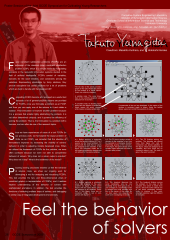 Constraint satisfaction problems (CSPs) and one of its extensions fuzzy CSPs (FCSPs) are simple models for formulating problems that exist in the real world. There are a lot of general-purpose solvers for FCSPs, and once we formulate a problem as an FCSP and then can have one of the solvers solve it. This formulation is however another problem because it is a process that entails highly abstracting the problem, it is not often determined uniquely, and it governs the efficiency of solving the problem. The authors consider that it improves this situation to increasing the visibility of solvers' behavior in order to adjusting models developed once. In this paper, the authors show their ongoing work for developing a tool for analyzing and visualizing FCSPs, which provides two- and three-dimensional views of FCSPs and shows the behavior of solvers with animations.
Constraint satisfaction problems (CSPs) and one of its extensions fuzzy CSPs (FCSPs) are simple models for formulating problems that exist in the real world. There are a lot of general-purpose solvers for FCSPs, and once we formulate a problem as an FCSP and then can have one of the solvers solve it. This formulation is however another problem because it is a process that entails highly abstracting the problem, it is not often determined uniquely, and it governs the efficiency of solving the problem. The authors consider that it improves this situation to increasing the visibility of solvers' behavior in order to adjusting models developed once. In this paper, the authors show their ongoing work for developing a tool for analyzing and visualizing FCSPs, which provides two- and three-dimensional views of FCSPs and shows the behavior of solvers with animations.
- “ウィジェットの適応レイアウト問題”,若手研究者支援のための産学協同GCOEシンポジウム, 北海道大学, 札幌, 2008年10月3日.
Abstract
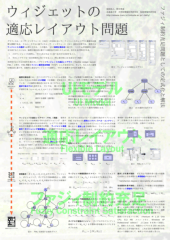 本稿ではウィジェットの適応レイアウト(FWL)問題をファジィ制約充足問題(FCSP)として定式化する.グラフィカル・ユーザ・インタフェースの自動生成において,ウィジェットのレイアウトの最適化は重要な課題の一つである.さらに,モデルに基づいたユーザ・インタフェース(UI)設計の分野では,UIの論理仕様記述の要求を満たすウィジェットの中から最適なものを選択することも必要となる.そこで本研究では,使用するウィジェットとその並べ方を決定すること,そのレイアウトをある時間内に完了させることの2点が要求されるレイアウトをFWLと呼び,決定の望ましさをファジィ制約として定式化することによって,FWLの解法を示す.
本稿ではウィジェットの適応レイアウト(FWL)問題をファジィ制約充足問題(FCSP)として定式化する.グラフィカル・ユーザ・インタフェースの自動生成において,ウィジェットのレイアウトの最適化は重要な課題の一つである.さらに,モデルに基づいたユーザ・インタフェース(UI)設計の分野では,UIの論理仕様記述の要求を満たすウィジェットの中から最適なものを選択することも必要となる.そこで本研究では,使用するウィジェットとその並べ方を決定すること,そのレイアウトをある時間内に完了させることの2点が要求されるレイアウトをFWLと呼び,決定の望ましさをファジィ制約として定式化することによって,FWLの解法を示す.
Theses
- “User Interface Architecture with Abstract Interaction Description”,博士論文, 北海道大学大学院情報科学研究科, 2009年2月.
Abstract
The topic handled in this thesis relates to the field of human computer interaction, and user interfaces (UIs), which are sometimes called human interfaces. There are many studies about this topic; they are roughly separated into three types: developments of actual UIs such as new devices and new applications, evaluations or developments of evaluation methods for existing or newly introduced UIs, and offers of new kinds of frameworks, architectures, and concepts for UIs, The study mentioned in this thesis mainly belongs to the third type, and its part belongs to the first one. In this chapter, I introduce the terms and their definitions used in the field of HCI, explain the objective of this thesis, and mention the structure of the following chapters of this thesis.
- “抽象インタラクション記述言語を用いたユーザ嗜好インタフェースの設計”,修士論文, 北海道大学大学院情報科学研究科(平成17年度修士論文), 2006年2月.
Abstract
本研究はサービス・アーキテクチャであるインタフェース・クライアント/ロジック・サーバ構造(ICLS)を提案する.ICLS は特定のインタフェースに固有な処理を行うインタフェース・クライアントと,すべてのインタフェース処理に共通な処理とサービス・ロジック処理を行うロジック・サーバから構成される.そして両者は,ユーザとサービスとのやり取りを抽象インタラクション記述言語(AIDL)を用いて記述したインタラクション・グラフによって,特定のインタフェースに依存せずに連携する.サービスにICLSを採用することによって,インタフェースの容易な取り替えと自由度の高いカスタマイズ性からなるユーザ嗜好インタフェースが実現する.本研究では,これをフレームワークとして実装することにより,そのようなサービスの開発を容易にする.
- “木構造モデルによるインタフェースとロジックの分離に関する研究”,学士論文, 北海道大学工学部(平成15年度学士論文), 2004年2月.
Abstract
今日,交通機関の時刻案内やチケット予約,書籍やCDの通信販売といったサービスが広く利用されるようになり,また外出先から操作可能なビデオや炊飯器などの情報家電製品が登場してきた.しかし現状のアプリケーション(サービス)には,それぞれ別々の操作方法を習得する必要があったり,ユーザの様々な使用環境に対しGUIしか提供されていないという問題がある.
ところがアプリケーションごとにインタフェースを実装する現状の方式では,問題解決のためにすべての操作方法を統一することは現実的ではなく,アプリケーションの提供者が複数のインタフェースを用意することもコストの面から困難である.従来研究として,似た形態のインタフェースの記述統一を目的としたインタフェース記述言語UIMLや,GUIインタフェースを文字情報に変換する研究があるが,問題解決には至っていない.
そこで本研究では,複数のアプリケーションでユーザが好みのインタフェースを統一して使え,また状況に応じて様々なインタフェースに取り替えられるようにすることを目的として,提示選択インタラクション・モデルとインタフェース・クライアント―ロジック・サーバ関係という手法を含む新しいアプリケーション・システムを提案する.またそれぞれについて手段としてインタラクション記述言語と木構造同期プロトコルの2つについても合わせて提案し,その実装例を示す.